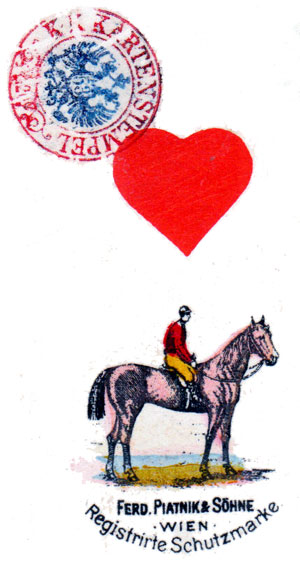Tarok c.1900
Piatnik & Söhne “Industrie und Glück” Tarok c.1905-1910.
“Industrie und Glück” Tarot c.1905
French-suited “Industrie und Glück” or “Rural Scenes” tarot deck manufactured by Ferd. Piatnik & Söhne, Vienna & Budapest, c.1905. The Trumps have large Roman numerals and feature scenes from daily life, mostly happy and often romantic (different at each end), which had replaced the earlier Animal tarots.
Ferdinand Piatnik’s sons had joined the business in 1882, when “& Söhne” was added to the company name, as shown on the knaves of clubs and diamonds. This changed to “Ferd. Piatnik & Söhne A.G.” when the firm became a limited company in 1917.
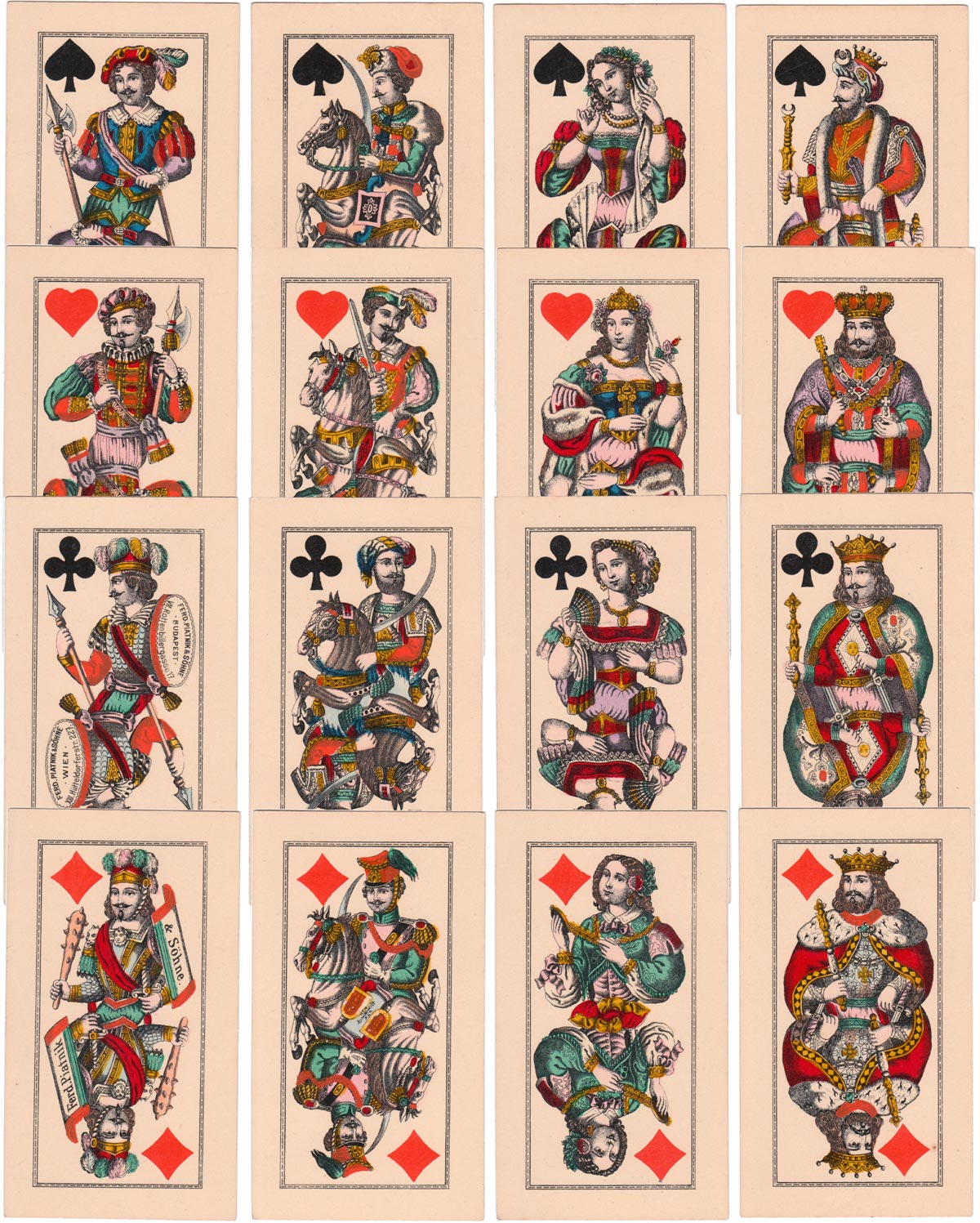
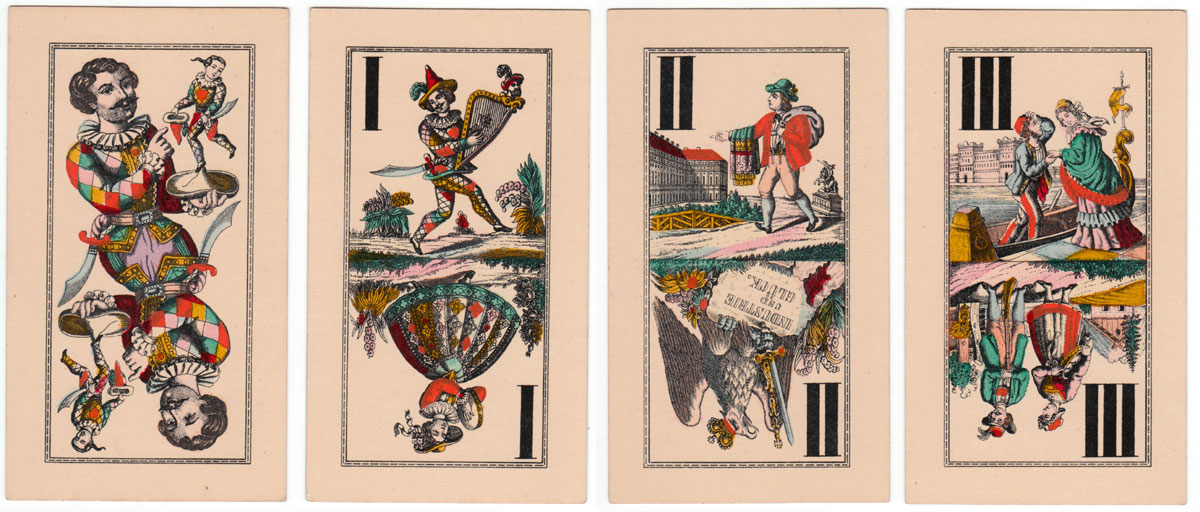
Above: 54-card “Industrie und Glück” or “Rural Scenes” tarot deck based on designs by J. Neumayer, manufactured by Ferd. Piatnik & Söhne, Vienna & Budapest, c.1903-1910. Stencil coloured lithography, square corners and no indices. Images courtesy Rex Pitts.
Right: detail from the knave of clubs showing both the Vienna and Budapest branch addresses
Hütteldorferstrasse 227, Vienna was used during the early 1900s. Rottenbillergasse 17, Budapest was used from about 1903→
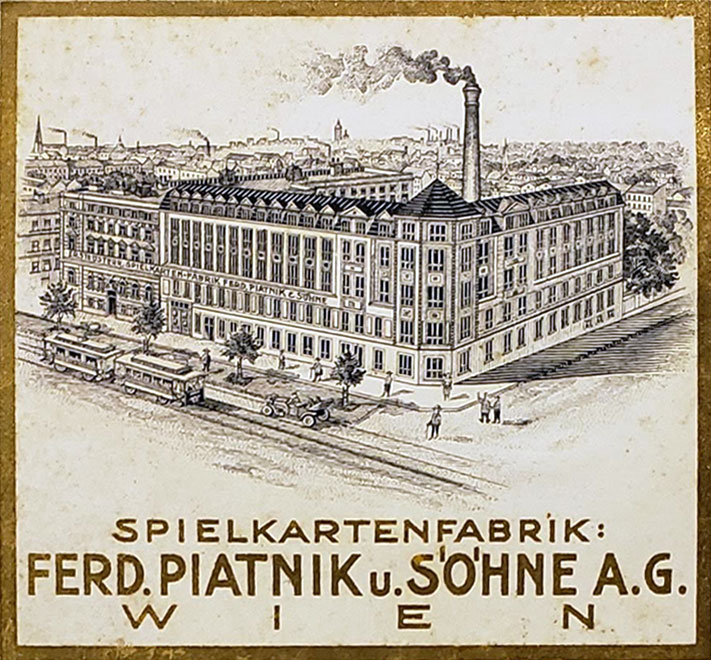
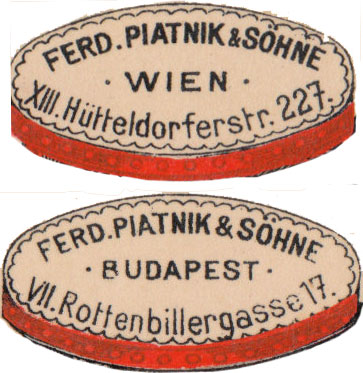

By Rex Pitts (1940-2021)
Member since January 30, 2009
Rex's main interest was in card games, because, he said, they were cheap and easy to get hold of in his early days of collecting. He is well known for his extensive knowledge of Pepys games and his book is on the bookshelves of many.
His other interest was non-standard playing cards. He also had collections of sheet music, music CDs, models of London buses, London Transport timetables and maps and other objects that intrigued him.
Rex had a chequered career at school. He was expelled twice, on one occasion for smoking! Despite this he trained as a radio engineer and worked for the BBC in the World Service.
Later he moved into sales and worked for a firm that made all kinds of packaging, a job he enjoyed until his retirement. He became an expert on boxes and would always investigate those that held his cards. He could always recognize a box made for Pepys, which were the same as those of Alf Cooke’s Universal Playing Card Company, who printed the card games. This interest changed into an ability to make and mend boxes, which he did with great dexterity. He loved this kind of handicraft work.
His dexterity of hand and eye soon led to his making card games of his own design. He spent hours and hours carefully cutting them out and colouring them by hand.
Related Articles

Luditz Pattern by Georg Geiselreiter
The discovery of 2024 changes the current state of knowledge of the history of this pattern.

Austrian Tarock by S.D. Modiano
Modiano’s Austrian Tarock with country scenes has been in production for over 100 years.

Ukraine playing cards
Historical figures from Ukraine’s past in a familiar Piatnik style.

MITSCHKAtzen
Clever cat designs by the Austrian artist and illustrator Willi Mitschka.

Tarock Cards by NIL Spielkartenfabrik
A deck of tarock cards from the eastern end of the ending Austro-Hungarian Empire.

Whist by Ditha Moser
Ditha Moser created this minimalist Whist deck in 1905, in the style of the Vienna Secession art mov...

Alan Tarot Deck
Reprint of a Tarock pack originally designed by Argio Orell for the Austrian Lloyd shipping company....

Gabriel Uffenheimer
Rare example of the production of Johann Gabriel Uffenheimer, Guntramsdorf, 1825.

Play Architecture
Twentieth century architects and their creations on a well-designed pack from Finland.

Art pack I
Art pack featuring Old Masters, including Bruegel, Vermeer, Titian, Raphael, Caravaggio, Canaletto, ...

Karl Korab
Austrian artist Karl Korab’s first pack, displaying his use of different techniques.

Jeu de Tarot (Catel & Farcy)
Colourful version of a standard French (‘Bourgeois’) Tarot.

Johann Nejedly Tarok Cards
Johann Nejedly, a 19th-century Viennese card maker, produced Tarock cards featuring modern scenes th...

Austria Ski Team playing cards
Photos of members of the Austrian skiing team replace the normal courts on two different packs.

Grunwald 1410 – The Battle of Tannenberg
Details from the famous painting of the Battle of Grunwald (1410) by the Polish painter Jan Matejko....

Paris 2024 Olympics 2
A standard French Tarot game pack with passing references to the Paris 2024 Summer Olympic Games.
Most Popular
Our top articles from the past 28 days













































